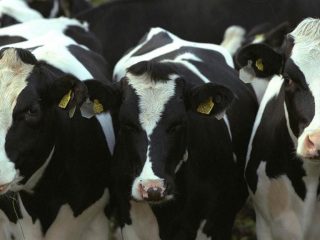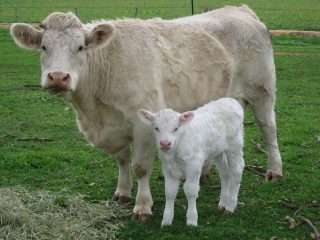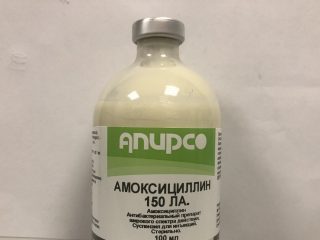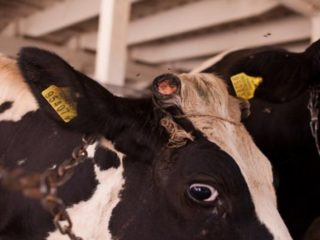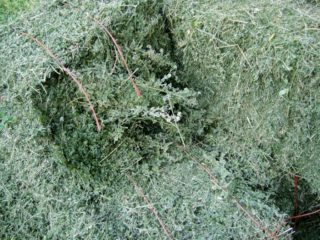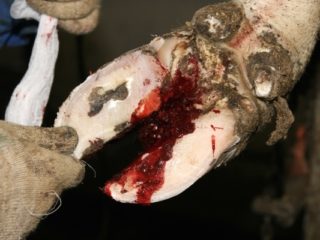Content
Many people think that feeding calves for rapid growth is necessary with hormonal drugs. It is possible, but this does not negate the need for a properly balanced diet. Moreover, many "growth boosters" are actually a collection of vitamins and minerals.
In the case of cattle, it is also necessary to separate the concepts of "growth at the withers" and "muscle growth". The former is optional and sometimes harmful. The second is at the request of the owner.
Pros and cons of using growth stimulants for cattle
From the point of view of beef cattle breeding in the use of stimulants, including growth hormones, there are no disadvantages for gobies. Some solid pluses:
- animals gain weight quickly;
- the terms of feeding are reduced;
- lethal output from the carcass is more.
Nobody cares about the condition of joints, bones and ligaments of future steaks. The situation is different with pedigree and dairy cattle. These animals do not need large muscle mass. Here you can already see not only the pros, but also the cons of rapid growth and development.
The use of growth hormones for pregnant cows will lead to the development of an overly large fetus. As a result, complications during calving are not excluded, and dairy cattle should bear offspring annually. Therefore, it is worth considering when looking at advertisements for growth hormones for cattle. If the manufacturer claims that the product is suitable for use on pregnant animals, most likely he is disingenuous.
Even worse are artificial growth stimulants for breeding calves raised for the tribe. In young animals, tubular bones grow the fastest. Due to them, there is an increase in height at the withers. Measurements show that in young animals the skeleton develops unevenly: now the withers are higher, then the sacrum, then the growth generally stops for some time.
During such stops, the tendons that hold the joints together have time to "catch up" with the bones. A fully formed animal has a good ODA.
But if stimulants were used, the balance between skeletal and muscular development is disrupted. The use of hormones gives too much muscle mass to still weak bones and articular ligaments. Other stimulants provoke accelerated bone growth. Weak joints and shortened tendons are the result.
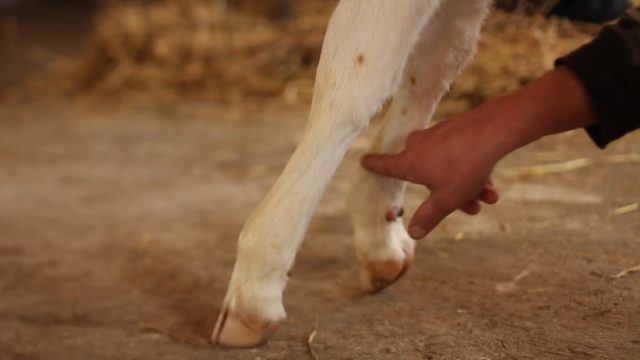
If a small calf is fed too intensively, under heavy weight and due to rapid growth, the tendons do not have time to develop normally, in this case, contractures often appear
At the same time, hundreds of years ago, people noticed that an animal on good and abundant food grows larger than its relatives. Therefore, the best growth promoter for calves intended for breeding or for milk production is a balanced diet. High-quality forage can be supplemented with feed antibiotics, which will allow the animal's body not to waste energy on fighting diseases.
Calf feed for fast growth
The first step is to feed the calf with natural cow's milk. In the first two weeks, young animals develop very quickly and gain weight, feeding only on milk. In the first 2 hours of life, a newborn should receive about 10% of its weight with colostrum. Gradually, the daily dose of milk is increased and brought to 12 liters.
Inexperienced cattle owners get the wrong impression that it is best to feed a small calf with milk and hay.
Often this theory is adhered to by fans of the "natural lifestyle". After all, the calves of wild tours did not receive any other food, except for grass and milk. But wild prototypes are always smaller than their domesticated counterparts. The "experimenters" are convinced by their own experience that the theory is wrong and change their minds. The best feed for fast growth of calves is cereal concentrates. They begin to be added from the 3rd week of the cub's life. With abundant feeding with milk and nutritious fodder, the daily weight gain of young cattle is about 1 kg.
It is best to use commercially prepared calf feed. The antibiotics and hormones that are frightening to everyone are absent. These additives are administered separately as needed.
A high-quality starter feed for young animals contains the nutrients necessary for rapid growth and muscle gain. First of all, it is a protein and a vitamin and mineral complex.
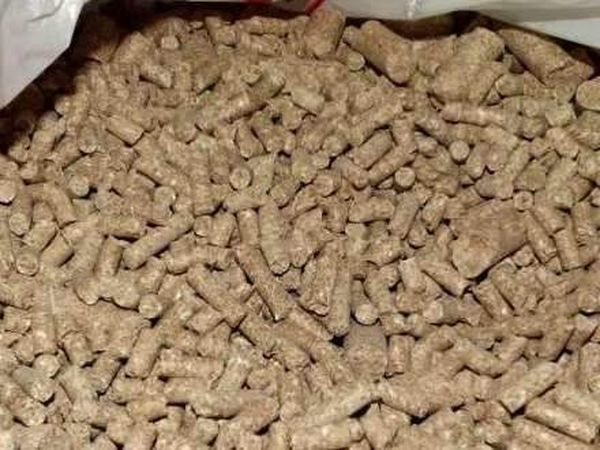
Starting pellets can be fed to calves from the moment they try something other than milk.
Starter feed
Designed for calves from 0 to 6 months of age. In Russia, you can buy feed from Krasnodar production: "Vitula", "Venera", "Elegance".
The first two are for calves up to 3 months of age. The granules are added gradually and by the age of 90 days they are brought to 1.6 kg per day. Elegance is the next stage. It is used at the age of 3-6 months. The maximum daily dose is 3.5 kg. Later, in order to reduce the cost of fattening, calves are gradually transferred from Elegance to regular forage with vitamin and mineral premixes.
The same manufacturer offers 2 feed additives as growth accelerators: CattlePro Littlegoby and CattlePro BestVil. They look like regular granules. "BestVil" is used after six months, mixing with the main fodder. The additive replaces 15-30% of the main grain ration. Littlegoby is used for calves from 3 to 6 months, if expensive starter feed is replaced with cheaper grain. The share of this additive is also 15-30%.
All products from this manufacturer contain coccidiostatics that prevent the development of coccidiosis. Even if the feed does not accelerate weight gain in calves, the absence of parasites is in itself a growth promoter.
There are other growth promoters that are not related to forage or feed additives.
Growth preparations for cattle
Growth stimulants for calves include:
- vitamin formulations for injections;
- antibiotics;
- hormonal.
Which variety to choose to stimulate rapid growth depends on the situation. But most often vitamins and feed antibacterial agents are used.
Vitamin and mineral complexes
Dietary supplements are the very same vitamin and mineral complexes that must be used not only for fattening. There are no regions in the world that are ideally balanced in all the necessary animal elements. In each specific area of residence, the missing substances must be added to the feed for livestock. But this is determined with the help of laboratory tests, therefore, it is impossible to indicate the specific names of vitamin-mineral stimulants of cattle growth in a general article. Most often these are vitamin and mineral solutions for injections. On hearing one of these biostimulants - Catosal.
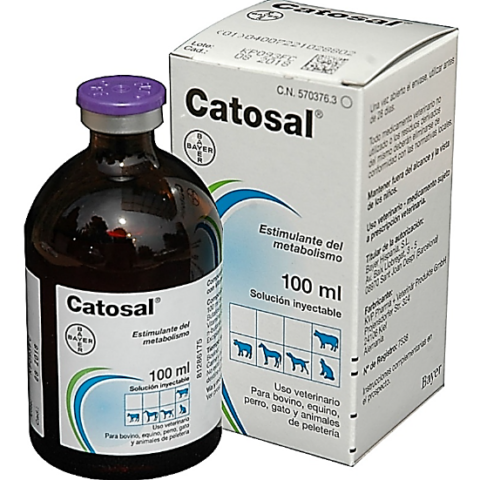
It is often believed that if you have Catosal, you can feed the calf with the cheapest grain and not really pamper the animal with other additives.
Catosal
In fact, it contains only 2 active ingredients: a phosphorus derivative and a vitamin B₁₂ derivative. It is used as a tonic, as it speeds up metabolism and improves immunity.
Catosal is produced in the form of a liquid for injection. Calves are injected subcutaneously, intramuscularly or intravenously. But there is no application scheme for fattening beef cattle.User reviews of Catosal are skeptical. And this is not surprising. No stimulant gives magical results. For good growth of cattle, in parallel with injections of Catosal, animals need to be well fed and provided with a set of vitamins and minerals.
Eleovite
Another vitamin injection solution. The composition of this product is rich: 12 vitamins. Release form: liquid for injection. The color is yellowish or brownish. Has a specific smell. The vitamins that make up Eleovit are involved in the metabolism of fats, proteins and carbohydrates. It is used to treat diseases that are associated with metabolic disorders. The manufacturer does not mention the rapid growth. Dose for cattle: adult animals - 5-6 ml, calves - 2-3 ml. Intramuscular or subcutaneous injections.
Feed antibiotics
In addition to coccidiosis, calves can also contract other infections. Coccidiostatics in feed do not help in this case. To protect young animals from other diseases in animal husbandry, feed antibiotics are used. Experiments have shown that the animals fed with these veterinary drugs outperformed the control group in terms of productivity by 2-14%.
Unrefined preparations containing proteins and vitamins are added to the food of calves. Feed antibiotics include:
- biomycin;
- chlortetracycline;
- oxytetracycline.
These are "pure" substances that do not give in this form. Commercially available native antibiotics are known by brand names and additives rather than medications.

Calves are fed with native additives, if they offer a similar antibacterial agent for injection in a hermetically sealed bottle, this is an antibiotic for treatment
Biomycin
You can buy it under the name "Biokorm-1". Light brown powder that remains active for 6 months. The content of the active substance in 1 g of "Biokorm-1" is 900-1000 units. It also contains B vitamins, which are often considered growth stimulants. Compensates for the lack of essential micronutrients.
Chlortetracycline
Trade name "Biokorm-4". Brown-black powder with a shelf life of 3 months, 1 g contains up to 30,000 IU of active substance. In addition to the antibiotic, vitamin B₁₂ is present.
Oxytetracycline
Sold as Terramycin native. The culture is grown on crushed grain. In finished form, it is a light brown powder with a sharp smell of mold. The shelf life is six months. 1 g contains 3-4 thousand units of oxytetracycline. In addition to the antibiotic, protein, fat, nitrogen-free substances and B vitamins are present in large quantities. Good growth stimulant.
Hormonal stimulants
The main horror story of consumers of meat products. In fact, the real hormonal stimulant is a gene mutation that causes the calf to produce myostatin. This is also a hormone, but it stops the growth of muscle mass. The change in the gene led to a complete blockage of its work. In the animal kingdom, this mutation is quite common, but it was fixed only in the beef cattle breed: Belgian blue.
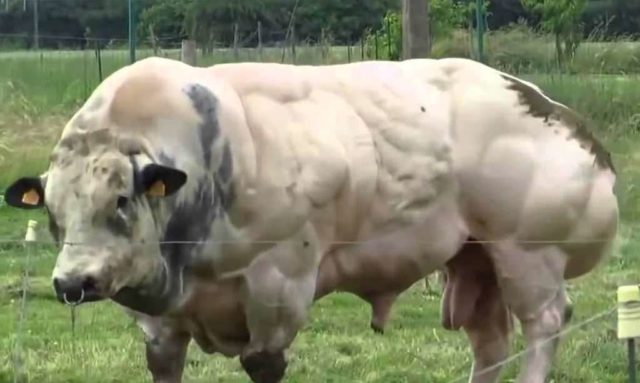
A calf of any breed other than the Belgian Blue will not show such a result, no matter how you feed it and what growth stimulants you use.
Artificial hormonal growth stimulants will not give the desired effect without high-protein concentrates and "training", that is, active movement.
Nucleopeptide
The main function of this hormonal drug is to stimulate muscle gain. It is obtained from the spleen of cattle. Outwardly, it is a cloudy liquid. The color range is from light yellow to yellow-brown. Foams easily when shaken. When stored for a long time at rest, a precipitate forms, which easily breaks up after shaking.Packing: 5, 10, 100 ml. The vials are hermetically sealed with polymer lids.
The same applies to those packages, the liquid from which was taken with a syringe through the lid.
Mechanism of action
The substances contained in the nucleopeptide stimulate the secretion of thyroid and androgenic hormones. The manufacturer claims no more than physiological amounts.
Thyroids have a complex effect:
- activate the synthesis of growth hormone;
- stimulate the development and growth of the calf;
- accelerate the set of muscle mass;
- have an anabolic effect.
The drug also increases the body's resistance to disease. A calf that has not been ill will always grow larger than the one that was seriously ill in its youth.
When using a nucleopeptide, muscle mass increases by 12-25%. The feed conversion is also improved. The agent can be used in parallel with native antibiotics and vitamin and mineral premixes.
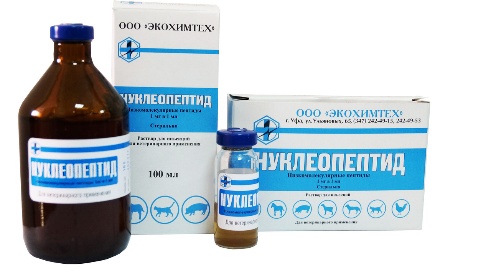
The nucleopeptide speeds up the metabolism, so the calf needs to be fed more and more often than those on whom the stimulant for rapid growth was not used
Gamavit
A hormonal preparation based on denatured emulsified placenta and sodium nucleinate. The starting material for the latter is yeast cultures. Gamavit is produced in liquid form. Usually used by injection.
The product contains biological substances that increase immunity and optimize metabolic processes. Used for prevention and treatment:
- hypovitaminosis;
- anemia;
- pyometra;
- poisoning;
- toxicosis;
- invasive and infectious diseases.
It is also used as a tonic in the postoperative period. Gamavit is also useful in preparing animals for exhibitions and competitions. But the annotation does not say anywhere that it stimulates growth. Perhaps indirectly. The manufacturer advertises the product as a growth stimulant as well.
Owners of productive farm animals have tried to pierce calves and piglets with gamavit for growth. Opinions were divided. Owners of chickens who soldered the drug on chickens say that the birds gained weight well. Piglet and calf owners believe that distilled water could be injected with equal success instead of a stimulant. The manufacturer claims that a lot of fakes have appeared and one must be careful when buying.
Rules for the use of cattle growth accelerators
All growth stimulants are used not only for cattle, but also for other animals. Depending on the type of mammal, the scheme of use also changes.
In the first months of a calf's life, stimulants are not used. Young animals are fed with high-quality starters, hay and milk. Rapid growth stimulants will be required when the bull is fed.
Due to the wide variety of growth accelerators, there is no unified scheme for their use. Each stimulant must be accompanied by instructions. If not, the drug is most likely intended for other purposes. Rapid growth with this remedy is either coincidence, side effect, or self-deception.
The nucleopeptide is used for fast fattening of gobies. And there is an instruction on how to use the product for this very purpose. To stimulate immunity, the nucleopeptide is injected intramuscularly or subcutaneously at 0.1-0.2 ml / kg of live weight once every 24 hours for a course of 3 days.
When used as a growth stimulator for fattening calves, injections are given in the middle of the neck subcutaneously. The dosage is 0.1-0.2 ml / kg. No more than 30 ml can be injected into one place. Injections are given 4 times with an interval of 15 days.
The main rule of using products for rapid growth is high-protein concentrates ad libitum. You can use the best and most expensive stimulants for fast growth, but if you don't feed the calf, it won't grow.He will simply have nowhere to take "building material" for his body.
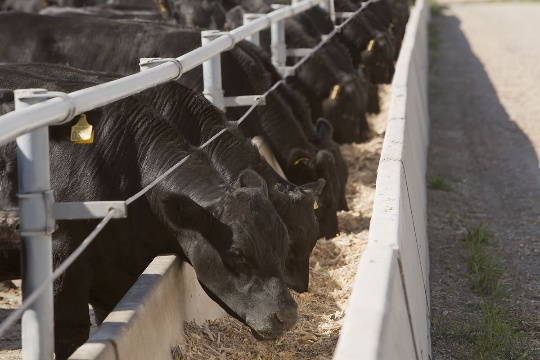
To get good muscle mass, you will have to feed the calves well, the principle “to earn a lot, you have to invest a lot” works here.
The opinion of veterinarians
The effect of growth promoters on the rapid muscle gain in calves is somewhat exaggerated. The growth of bulls is influenced by:
- genetics: never a dairy calf will gain weight as quickly as a beef calf;
- a high-quality diet: if you try to save money and feed the calf with cheap grain in insufficient quantities, even the Belgian blue goby will grow up as a wretched calf;
- providing animals with the necessary microelements and vitamins: with avitaminosis or a lack of any element, the growth of animals often stops;
- good housing conditions: the calf, which wastes its strength in the struggle for survival, grows slowly.
And only if these conditions are met, you can try to accelerate the weight gain by the bulls using artificial means.
The use of rapid growth stimulants for cattle injections is seductive but can be dangerous. Excess vitamins obtained orally will not be absorbed and will be excreted from the body naturally. When the vitamin composition is injected, even unnecessary will enter the body. Growth hormone stimulants can upset your natural balance. The result will not be accelerated weight gain, but hormone production problems.
Conclusion
To feed calves for rapid growth is necessary, first of all, high-quality products containing a large amount of protein. No hormones and antibiotics will help an animal gain weight if it has nothing to "build" muscle tissue from.
